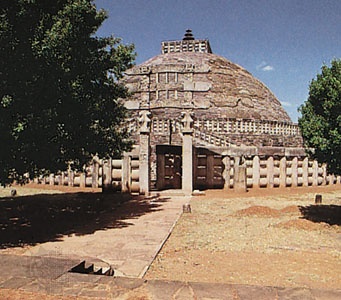Sānchi
historical site, India
also spelled Sāñcī
 historic site, west-central Madhya Pradesh state, central India, just west of the Betwa River. On a flat-topped sandstone hill, rising 300 feet (90 m) above the surrounding country, stands the best-preserved group of Buddhist monuments in India. Most noteworthy is the Great Stupa, discovered in 1818. It was probably begun by the emperor Aśoka in the mid-3rd century BC and later enlarged. Solid throughout, it is enclosed by a massive stone railing pierced by four gateways on which are elaborate carvings depicting the life of the Buddha. The stupa itself consists of a base bearing a hemispherical dome (aṇḍa) representing the dome of heaven enclosing the Earth; it is surmounted by a squared rail unit, or harmikā, the world mountain, from which rises a mast (yaṣṭi) to symbolize the cosmic axis. The mast bears umbrellas (chatras) that represent the various heavens (devaloka). Other remains include several smaller stupas, an assembly hall (caitya), an Aśokan pillar with inscription, and several monasteries (4th–11th century AD). Several relic baskets and more than 400 epigraphical records have also been discovered.
historic site, west-central Madhya Pradesh state, central India, just west of the Betwa River. On a flat-topped sandstone hill, rising 300 feet (90 m) above the surrounding country, stands the best-preserved group of Buddhist monuments in India. Most noteworthy is the Great Stupa, discovered in 1818. It was probably begun by the emperor Aśoka in the mid-3rd century BC and later enlarged. Solid throughout, it is enclosed by a massive stone railing pierced by four gateways on which are elaborate carvings depicting the life of the Buddha. The stupa itself consists of a base bearing a hemispherical dome (aṇḍa) representing the dome of heaven enclosing the Earth; it is surmounted by a squared rail unit, or harmikā, the world mountain, from which rises a mast (yaṣṭi) to symbolize the cosmic axis. The mast bears umbrellas (chatras) that represent the various heavens (devaloka). Other remains include several smaller stupas, an assembly hall (caitya), an Aśokan pillar with inscription, and several monasteries (4th–11th century AD). Several relic baskets and more than 400 epigraphical records have also been discovered.- Heinrich Haymerle, Baron von
- Heinrich Heine
- Heinrich Hertz
- Heinrich Himmler
- Heinrich Hoffmann
- Heinrich Isaac
- Heinrich Julius
- Heinrich Julius Klaproth
- Heinrich Karl Brugsch
- Heinrich Kayser
- Heinrich Klüver
- Heinrich Lammasch
- Heinrich Leo
- Heinrich Louis d' Arrest
- Heinrich Lübke
- Heinrich Mann
- Heinrich Otto Wieland
- Heinrich Rickert
- Heinrich Rohrer
- Heinrich Schenker
- Heinrich Schliemann
- Heinrich Schütz
- Heinrich Suso
- Heinrich von Brentano
- Heinrich von Kleist